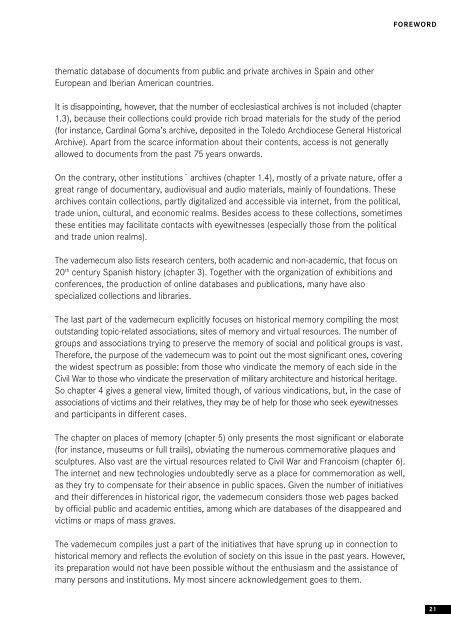Vademecum
Vademecum
Vademecum
You also want an ePaper? Increase the reach of your titles
YUMPU automatically turns print PDFs into web optimized ePapers that Google loves.
thematic database of documents from public and private archives in Spain and other<br />
European and iberian American countries.<br />
it is disappointing, however, that the number of ecclesiastical archives is not included (chapter<br />
1.3), because their collections could provide rich broad materials for the study of the period<br />
(for instance, Cardinal Goma’s archive, deposited in the toledo Archdiocese General Historical<br />
Archive). Apart from the scarce information about their contents, access is not generally<br />
allowed to documents from the past 75 years onwards.<br />
on the contrary, other institutions´ archives (chapter 1.4), mostly of a private nature, offer a<br />
great range of documentary, audiovisual and audio materials, mainly of foundations. these<br />
archives contain collections, partly digitalized and accessible via internet, from the political,<br />
trade union, cultural, and economic realms. Besides access to these collections, sometimes<br />
these entities may facilitate contacts with eyewitnesses (especially those from the political<br />
and trade union realms).<br />
the vademecum also lists research centers, both academic and non-academic, that focus on<br />
20 th century Spanish history (chapter 3). together with the organization of exhibitions and<br />
conferences, the production of online databases and publications, many have also<br />
specialized collections and libraries.<br />
the last part of the vademecum explicitly focuses on historical memory compiling the most<br />
outstanding topic-related associations, sites of memory and virtual resources. the number of<br />
groups and associations trying to preserve the memory of social and political groups is vast.<br />
therefore, the purpose of the vademecum was to point out the most significant ones, covering<br />
the widest spectrum as possible: from those who vindicate the memory of each side in the<br />
Civil War to those who vindicate the preservation of military architecture and historical heritage.<br />
So chapter 4 gives a general view, limited though, of various vindications, but, in the case of<br />
associations of victims and their relatives, they may be of help for those who seek eyewitnesses<br />
and participants in different cases.<br />
the chapter on places of memory (chapter 5) only presents the most significant or elaborate<br />
(for instance, museums or full trails), obviating the numerous commemorative plaques and<br />
sculptures. Also vast are the virtual resources related to Civil War and Francoism (chapter 6).<br />
the internet and new technologies undoubtedly serve as a place for commemoration as well,<br />
as they try to compensate for their absence in public spaces. Given the number of initiatives<br />
and their differences in historical rigor, the vademecum considers those web pages backed<br />
by official public and academic entities, among which are databases of the disappeared and<br />
victims or maps of mass graves.<br />
the vademecum compiles just a part of the initiatives that have sprung up in connection to<br />
historical memory and reflects the evolution of society on this issue in the past years. However,<br />
its preparation would not have been possible without the enthusiasm and the assistance of<br />
many persons and institutions. my most sincere acknowledgement goes to them.<br />
FoRewoRd<br />
21


